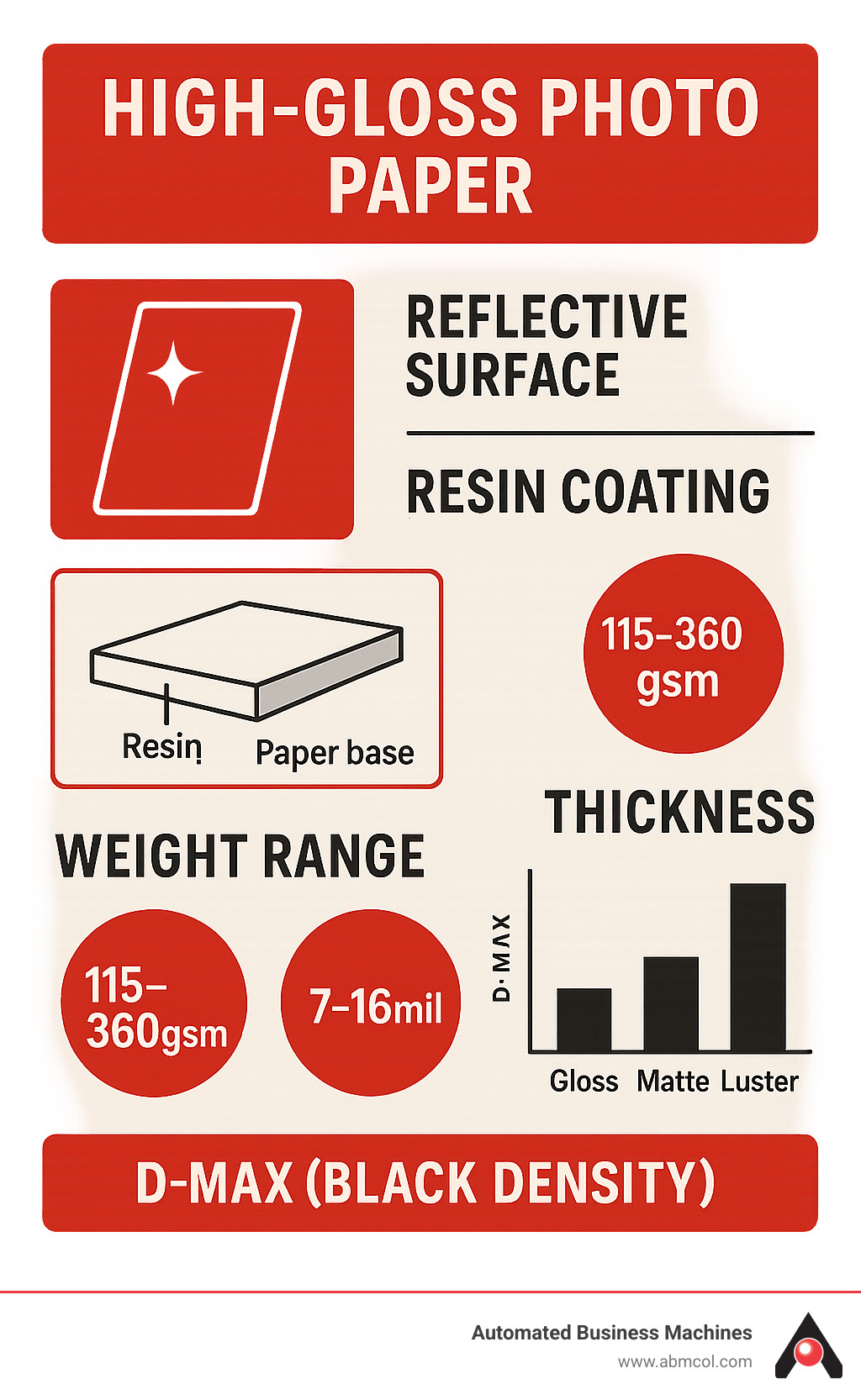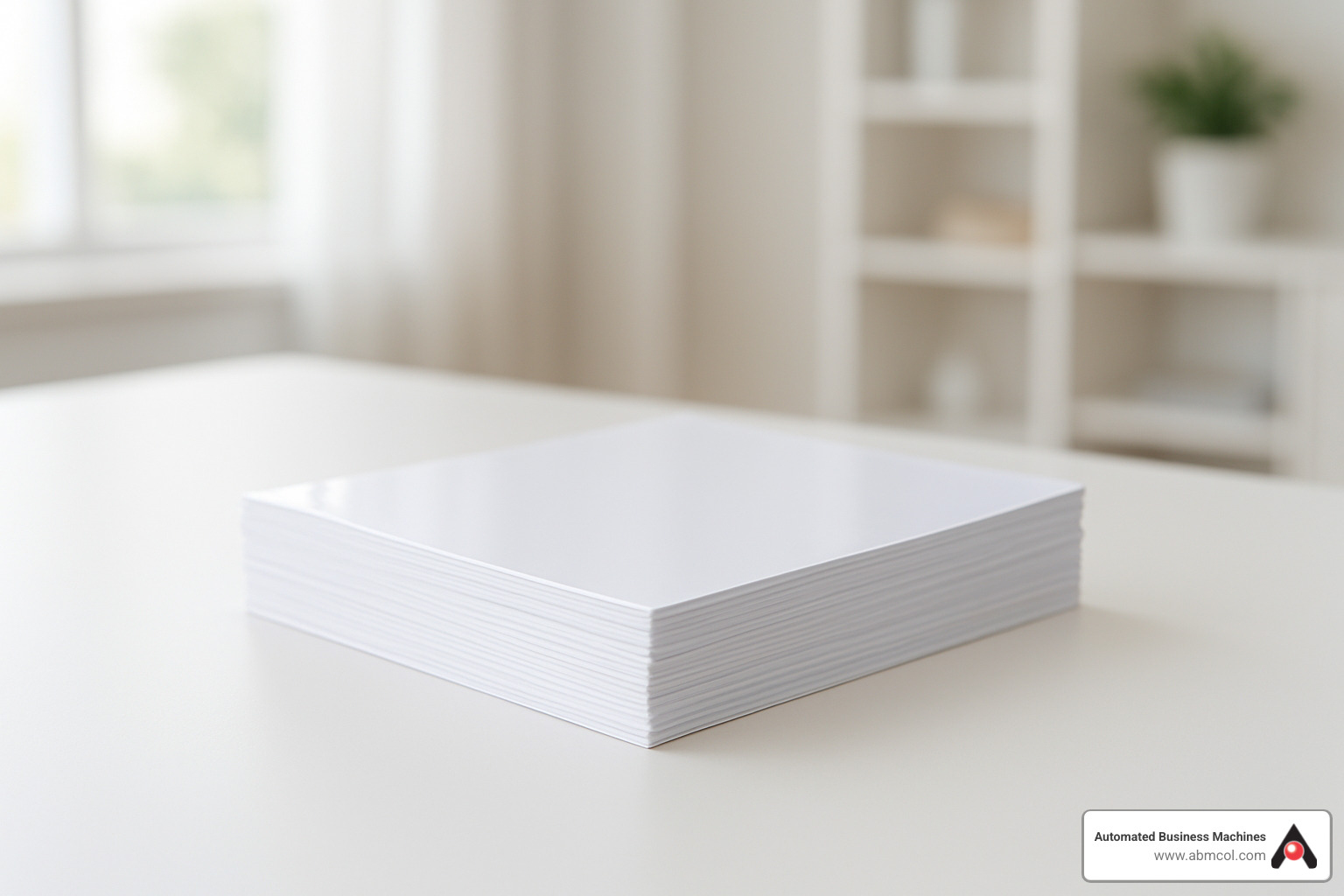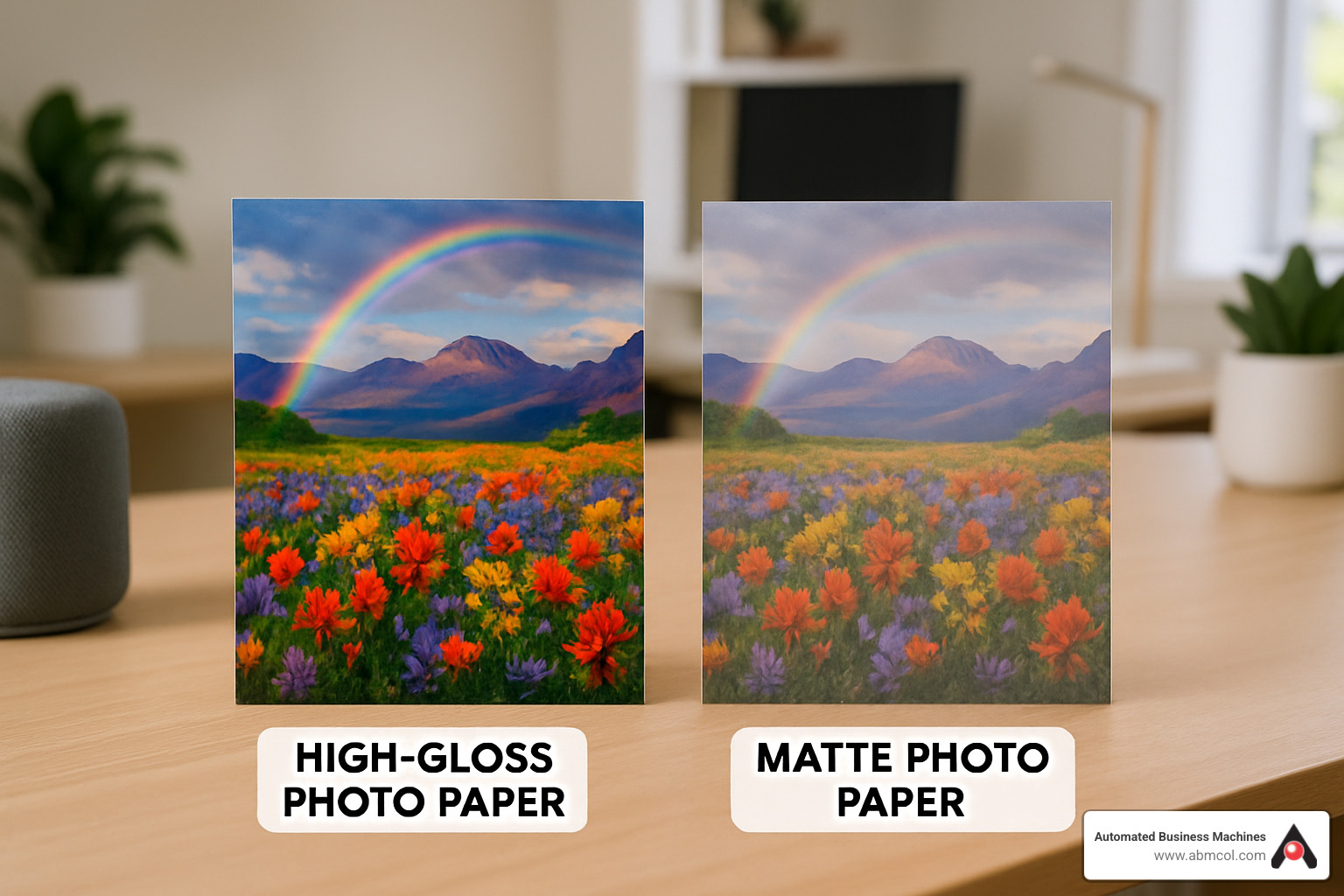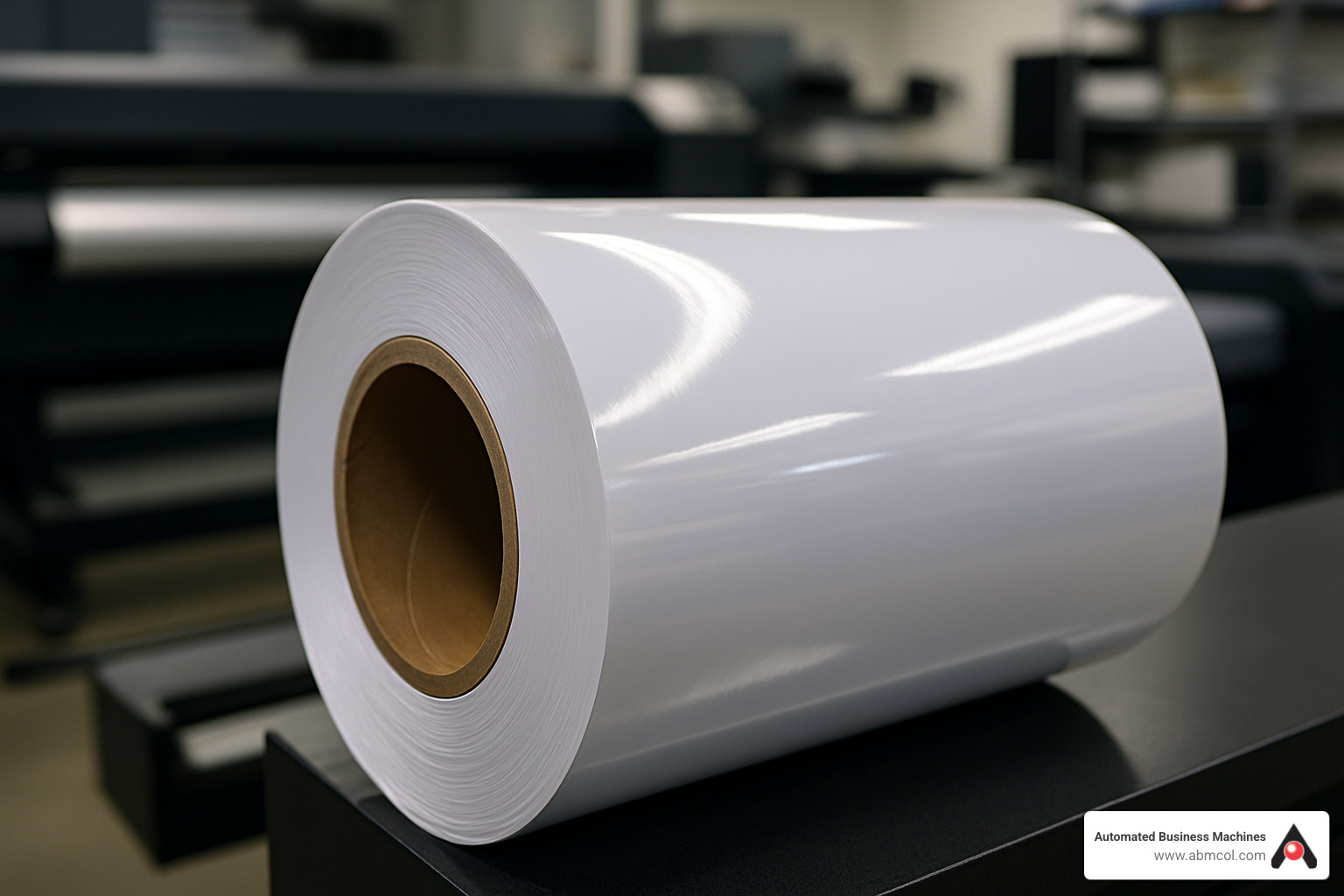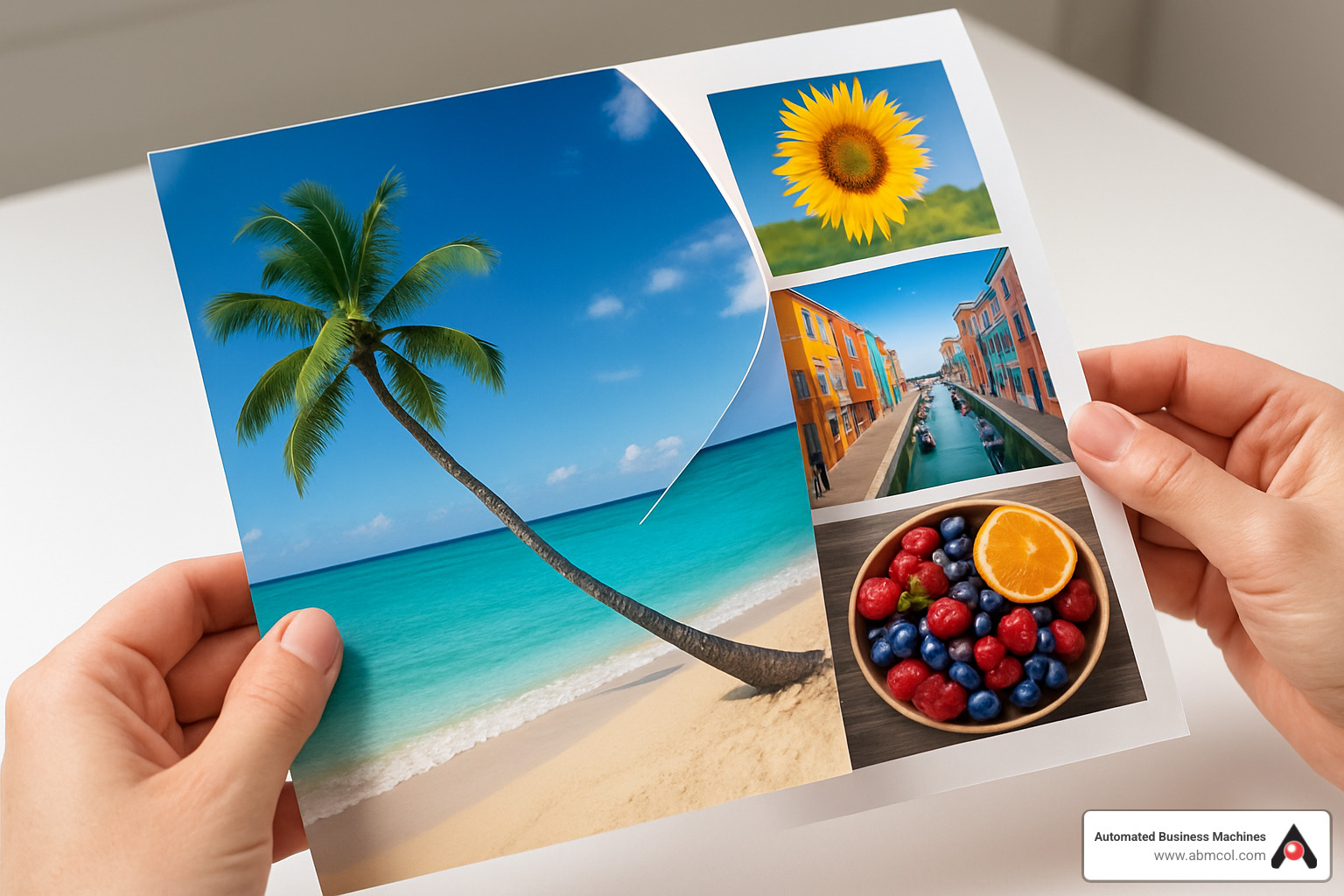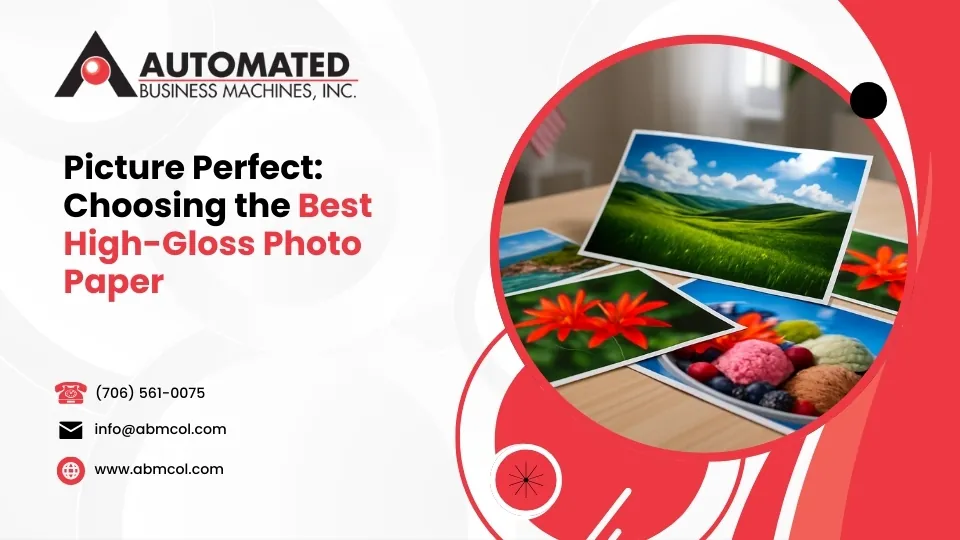
High-gloss photo paper is a specialized printing medium designed to produce vibrant, professional-quality photographs with exceptional color depth and detail. For those seeking a quick answer about this popular photo paper finish:
| High-Gloss Photo Paper Characteristics | Quick Facts |
|---|---|
| Finish Type | Highly reflective, mirror-like surface |
| Best For | Photographs with vibrant colors and deep blacks |
| D-Max (Black Depth) | Highest of all inkjet media types |
| Weight Range | 115 gsm (30 lb) to 360 gsm (96 lb) |
| Thickness | 7 mil to 16 mil |
| Key Benefits | Improved color saturation, sharpness, instant-dry |
| Common Sizes | 4×6″ to 60″ wide rolls |
| Popular Brands | Epson, HP, Koala, Red River |
When you print a cherished photo, the paper you choose matters as much as the image itself. High-gloss photo paper creates that professional photo lab look with its smooth, reflective surface that makes colors pop and details shine.
“Vibrant colors, deep blacks, and tack sharpness are the hallmarks of glossy photo papers,” notes industry experts. This is because the glossy coating (known as the “F-Surface” in photography) reflects light directly to the viewer’s eye, creating that distinctive high-contrast look.
What sets high-gloss apart from other finishes is its exceptional D-Max—the deepest black achievable on paper—making it the preferred choice for high-contrast images and photos that demand ultimate color density.
The resin coating on high-gloss papers serves multiple purposes: it prevents ink absorption into the paper fibers, keeps images on the surface where they appear most vibrant, and provides instant-dry, smudge-resistant properties that protect your prints.
Whether you’re printing family photos for albums, creating professional portfolios, or producing marketing materials, understanding how to choose the right high-gloss paper can make the difference between ordinary and extraordinary results.
Lightweight Gloss Sheets
Looking for that perfect balance between quality and value for your everyday photo printing? High-gloss photo paper in lightweight varieties might be just what you need. These thinner sheets typically weigh between 115 gsm (30 lb) and 180 gsm (48 lb), with a thickness of 7 to 8.5 mil – substantial enough for beautiful prints without the premium price tag.
What makes these lightweight options so special is their clever resin coating. Despite being thinner than their premium counterparts, they still deliver those eye-catching vibrant colors and crisp details that make glossy finishes so popular. Take the Koala Glossy Thin Inkjet Paper (115 gsm), for instance – it’s earned an impressive 4.6 out of 5 stars from over 5,200 Amazon reviewers, with more than 4,000 people snapping it up in just the past month!
“I was pleasantly surprised by how well this paper performed for DIY chip bags and brochures,” one happy customer shared. “The colors are vibrant, and it dried instantly with no smudging.”
That quick-drying feature is a real game-changer for home users. No more hovering anxiously over your printer, worried about smudging your freshly printed masterpiece! These papers feed smoothly through most standard inkjet printers without requiring special settings or awkward manual feeding.
If you’re using dye-based inks, you’re in for a real treat. The microporous coating on these lightweight glossy sheets captures ink droplets right at the surface rather than letting them sink in, giving you sharper images with richer colors that really pop off the page.
What makes lightweight gloss papers so practical? They’re budget-friendly for when you need to print lots of photos, they dry quickly to resist smudging, they play nicely with standard home printers, they showcase excellent color with dye-based inks, they’re flexible enough for various crafting trips, and they’re perfect for everyday photos where archival quality isn’t the top priority.
Whether you’re a small business creating eye-catching marketing materials or a family printing treasured memories without breaking the bank, lightweight gloss papers deliver professional-looking results at a price that makes sense.
Best for Snapshots & Scrapbooks
When it comes to printing those perfect 4×6 snapshots or creating beautiful scrapbook elements, lightweight high-gloss photo paper truly comes into its own. These smaller prints don’t need the structural heft of heavier papers, making lightweight gloss an economical and practical choice.
The instant-dry coating is a genuine blessing for scrapbooking enthusiasts. There’s nothing more frustrating than smudging a freshly printed photo or twiddling your thumbs waiting for prints to dry before continuing with your creative flow.
“I print dozens of 4×6 photos for my monthly scrapbooking sessions,” one customer raved. “The colors pop beautifully on this paper, and I can handle them immediately without worrying about smudges.”
For photo album enthusiasts, lightweight gloss papers offer several distinct advantages. They slide effortlessly into album sleeves without making your album bulge awkwardly. The glossy finish helps protect images from fingerprints when properly handled. Their slim profile lets you store more photos in the same space, and they’re wallet-friendly for printing large batches of family photos.
Scrapbookers particularly love how versatile these papers are. You can cut them, punch them, and even gently fold them without cracking – perfect for creative projects where photos might need custom shapes or integration into mixed-media designs.
For stunning snapshots on lightweight gloss paper, remember to select “Best” or “Photo” quality in your printer settings, choose the correct paper type (usually “Photo Paper Glossy”), allow prints to fully air dry before stacking, and handle by the edges to keep that glossy surface pristine.
High-Gloss Photo Paper: Standard Everyday Gloss
Moving up from lightweight options, standard high-gloss photo paper strikes that perfect sweet spot between quality and versatility for your everyday photo printing needs. These papers typically fall in the 200 gsm (52 lb) to 260 gsm (68 lb) range, with thicknesses between 9 and 10.5 mil – substantial enough to feel like a real photograph in your hands.
Take Epson Premium Photo Paper Glossy, for example. This popular choice features a basis weight of 68 lb (252 g/m²) and a thickness of 10.4 mil, with an impressive 97% opacity. What does this mean for your prints? Your images will appear vibrant and true-to-life, with virtually no show-through even when printing heavily saturated photos.
“Premium Photo Paper Glossy has a high gloss finish that is perfect for printing your favorite cherished photos and enlargements for use with glass frames and photo albums,” explains Epson’s product description. This perfectly captures why so many people choose standard gloss papers for their photo printing.
These papers hit the perfect middle ground for most photography needs. They’re substantial enough to feel like professional photographs, rigid enough to display unframed on a desk or in a portfolio, yet still flexible enough to feed reliably through most printers. They’re durable for handling and long-term storage, professional enough for client deliverables, and still affordable enough for regular use.
Whether you use dye or pigment inks, standard gloss papers perform beautifully – though for truly optimal results, try to match your paper to your printer’s ink system. Most printer manufacturers design their inks and papers to work together, creating a perfect harmony of color and longevity.
At Automated Business Machines, we’ve noticed that many of our Georgia customers across Atlanta, Augusta, Savannah and beyond gravitate toward this weight class for their everyday photo printing. It offers that professional quality look without requiring specialized handling or storage – perfect for both home users and businesses creating marketing materials.
For more information on the standard paper sizes that work perfectly with these papers, check out our Standard Printer Paper Size Information guide.
How High-Gloss Photo Paper Improves Color, Contrast and Sharpness
The science behind why high-gloss photo paper produces such eye-catching images boils down to three key factors: color gamut, contrast, and detail reproduction.
First, that glossy coating creates a smooth, non-absorbent surface that keeps ink droplets precisely where they land. This prevents the spreading or “feathering” that happens on more absorbent papers, resulting in sharper details and cleaner lines. If you looked under magnification, you’d see that text and fine details appear noticeably crisper on gloss paper compared to matte alternatives.
“High gloss inkjet paper offers the highest D-Max of all inkjet media,” explains Red River Paper, a respected industry source. This D-Max (maximum density) refers to how deep and rich the blacks appear – crucial for overall image contrast. Higher D-Max values translate to more dramatic shadows and greater perceived depth in your images.
The bright white base of most high-gloss papers amplifies this effect even further. Epson’s Premium Photo Paper Glossy, for instance, boasts an ISO brightness of 92, providing a clean, neutral starting point that allows colors to appear more accurate and vibrant.
Color gamut – the range of colors a paper can reproduce – expands significantly on glossy surfaces. The resin coating prevents ink from sinking into the paper fibers, keeping pigments on the surface where they appear most saturated. This results in more vibrant reds, blues, and greens; richer, deeper blacks; smoother gradients between colors; more accurate reproduction of subtle skin tones; and greater overall “pop” and visual impact.
For businesses producing marketing materials or photographers delivering client prints, these improvements in color, contrast, and sharpness make a meaningful difference in how your images are perceived. A product catalog printed on high-gloss paper will showcase merchandise with greater fidelity and appeal than the same images printed on standard office paper.
Common Drawbacks of High-Gloss Photo Paper
While high-gloss photo paper delivers stunning prints, it’s worth understanding its limitations to determine if it’s the right choice for your specific projects.
The most commonly mentioned drawback is glare. The same reflective properties that make colors pop can create distracting reflections when viewed under direct lighting. This becomes particularly noticeable with framed photos displayed opposite windows or under spotlights – sometimes making the image difficult to see from certain angles.
Fingerprints and handling marks present another challenge. The smooth, glossy surface readily shows oils from fingertips and can be easily marred by improper handling. As one customer review notes, “The prints look amazing, but I had to reprint several because of fingerprints during handling.”
Paper curling can also occur, especially with thinner gloss papers. Since the resin coating is applied to just one side of the paper, this can cause uneven expansion and contraction as humidity changes, leading to curling. Fortunately, this becomes less problematic with heavier weight papers (above 240 gsm).
Other potential limitations include difficulty writing on the surface with standard pens, potential for scratches on the delicate glossy surface, less forgiveness with overinking or heavy coverage areas, and challenges when scanning without reflections. These papers also aren’t ideal for images that will be handled frequently.
To keep your glossy prints looking their best, follow these simple care tips:
- Always handle prints by the edges or wear cotton gloves
- Store prints flat or in proper archival sleeves
- Display framed prints under glass and away from direct sunlight
- Allow prints to dry completely before stacking or storing
- Consider using a dehumidifier in storage areas in humid climates like Georgia
- Use proper printer settings to avoid overinking
- For frequently handled prints, consider semi-gloss or luster finishes instead
Understanding these trade-offs helps ensure you choose the right paper for each project. For example, a photo album that will be handled frequently might benefit from a semi-gloss finish, while a framed portrait for wall display might be better suited to high-gloss for maximum visual impact.
Heavyweight Pro Stock
When it comes to truly premium photo printing, heavyweight high-gloss photo paper stands in a class of its own. These professional-grade papers feel substantial in your hands – typically ranging from 275 gsm (72 lb) to an impressive 360 gsm (96 lb), with thicknesses between 11 and 16 mil that give your prints a presence that simply can’t be matched by lighter papers.
HP Professional Gloss Photo Paper exemplifies this premium category at 275 gsm and 9.8 mil thickness. It’s the go-to choice for professional photographers, high-end posters, and retail displays where image quality simply cannot be compromised. Similarly, Red River’s heavyweight options push the boundaries even further, reaching up to 360 gsm (96 lb) with a substantial 16 mil thickness that feels more like a photograph than a printed sheet.
“Prints have more richness and depth of color than with any paper I have used,” reports one professional photographer in a product review. This sentiment captures exactly why professionals choose heavyweight glossy stock – the best color density and image quality transform good photos into breathtaking prints.
The substantial weight and thickness of these papers deliver tangible benefits you can see and feel. Your prints gain exceptional durability that stands up to handling and display. There’s a premium feel that instantly communicates quality to clients. You’ll notice minimal curl even when humidity levels fluctuate (a common challenge in Georgia summers). The structural rigidity allows for confident unframed display, while the maximum D-Max values deliver the deepest possible blacks for dramatic contrast. Perhaps most importantly, these papers offer a superior color gamut that captures the most subtle details in your images.
You’ll find these premium papers available in both cut sheets and wide-format rolls, with roll widths up to 60 inches for large-format printing. The roll format is particularly valuable for art reproduction, exhibition prints, and commercial signage where custom sizes often make the difference between a good presentation and a great one.
| Feature | Standard Gloss | Heavyweight Gloss |
|---|---|---|
| Weight | 200-260 gsm | 275-360 gsm |
| Thickness | 9-10.5 mil | 11-16 mil |
| Feel | Good | Premium |
| Curl Resistance | Moderate | Excellent |
| D-Max | Very Good | Excellent |
| Durability | Good | Excellent |
| Typical Cost | $$ | $$$ |
| Best For | Home photos, portfolios | Gallery prints, client deliverables |
One important consideration with heavyweight papers is your printer’s capabilities. Many consumer printers have maximum paper weight limitations, and these heavier stocks often require manual feeding or dedicated rear paper paths. Professional-grade printers typically handle these weights without issue, but it’s always wise to check your printer’s specifications before investing in premium paper that might not feed properly.
Printer & Ink Compatibility Guide for Heavyweight High-gloss photo paper
Successfully printing on heavyweight high-gloss photo paper isn’t just about having the right paper – it’s about creating harmony between your printer, inks, and media. Think of it as a three-part relationship where all elements need to work together for the best results.
First, let’s talk printer compatibility. Not all machines are created equal when it comes to handling premium papers. Look for these key features in your printer:
A straight paper path makes all the difference with heavyweight papers. Printers with rear feed trays or manual feed slots typically work best because they don’t force the paper to bend around tight curves where it might crease or jam. If your printer only has a front tray with a curved path, you might be limited to lighter weights.
Check your printer’s maximum weight handling specifications. Many home and office printers max out around 300 gsm, while professional photo printers can handle 360 gsm or more with ease. Pushing beyond these limits isn’t just frustrating – it can damage your printer.
Don’t overlook the importance of feed settings. Most printers require special settings for heavyweight papers, so look for “Heavyweight,” “Premium Photo,” or similar options in your printer driver settings. These adjust the feed mechanism to accommodate thicker sheets.
Some professional printers allow adjustment of the platen gap – the space between the print head and paper. Increasing this gap slightly for thicker papers prevents head strikes that can smudge your prints and potentially damage your printer.
When it comes to inks, you have two main technologies to consider:
Dye-based inks create vibrant colors that seem to leap off glossy surfaces. They produce stunning results with excellent color saturation – perfect for prints that will make an immediate impact. However, they may fade faster than pigment inks, especially when exposed to light or humidity.
Pigment-based inks are the champions of longevity and fade resistance. Modern pigment formulations have dramatically improved in color gamut and glossiness compared to earlier generations, making them excellent choices for archival printing on heavyweight glossy papers that will be displayed for years.
“Match your paper, inks, and printer models designed to work together,” advises HP in their technical documentation. This co-engineering approach ensures optimal results, particularly with premium papers.
For the best results with heavyweight glossy papers, download and install the correct ICC profiles for your specific paper, allow extra drying time between prints when using pigment inks, and use “Photo Black” ink when available (as opposed to Matte Black). A test sheet before committing to large prints can save both paper and frustration, and keeping your printer’s firmware updated ensures you have the latest media handling improvements.
At Automated Business Machines, we regularly help businesses across Georgia determine the optimal printer configurations for their specific media needs, ensuring you get the most from your premium papers and equipment without the trial and error.
Storage & Display Tips for High-Gloss Photo Paper
Your investment in heavyweight high-gloss photo paper deserves proper care both before and after printing. With the right storage and display practices, your prints can maintain their vibrant appearance not just for years, but for decades.
Before printing, treat your premium paper with care. Keep it in its original sealed packaging until you’re ready to use it – this protects it from dust, light exposure, and humidity fluctuations. Store in a cool, dry place with stable temperature (65-75°F) and humidity (40-60%) to prevent warping or premature aging. Keep paper away from direct sunlight and fluorescent lighting, which can affect the brighteners in the paper even before printing. Always store sheets flat to prevent curling, and keep paper away from volatile chemicals, including cleaning supplies and solvents that can transfer to the paper surface.
Once you’ve created your masterpiece, proper display becomes crucial:
UV Protection makes all the difference in print longevity. “Prints on this paper can last up to 30 years for indoor displays when used with Original HP inks,” notes HP’s documentation. However, this longevity assumes proper protection from UV light. Always frame prints under UV-filtering glass or acrylic, especially in sunny Georgia locations where light exposure can accelerate fading.
Mounting Options help maintain the flatness of your prints over time. Heavyweight glossy prints benefit from proper mounting to prevent warping. Dry mounting to foam core creates a rigid, flat presentation ideal for larger prints. Float mounting offers a contemporary, frameless look that showcases the entire print. Traditional mat boarding with acid-free materials provides classic presentation while protecting print edges. For truly valuable or archival prints, consider museum mounting techniques that allow for future removal without damage.
Humidity Control presents a particular challenge in Georgia’s climate. The high humidity levels can affect even heavyweight papers over time, causing subtle waviness or, in extreme cases, mold growth. Use dehumidifiers in display areas during summer months when humidity peaks. Avoid displaying valuable prints in naturally humid spaces like bathrooms or kitchens. Select frames with sealed backs to minimize humidity fluctuations, and regularly monitor your prints for early signs of humidity damage like waviness or discoloration.
For businesses displaying marketing materials or photographs in office environments, these same principles apply. Properly displayed prints not only last longer but maintain their visual impact, ensuring your investment continues to impress clients and visitors. A stunning photograph printed on premium paper can set the tone for your entire office space – but only if it’s properly protected and displayed.
With proper care, your heavyweight glossy prints will continue to showcase your images with the same vibrance and impact as the day they were printed.
Specialty Gloss Papers: Eco, Metallic & Double-Sided
Beyond standard high-gloss photo paper, several specialty options offer unique features for specific applications. These innovative papers expand creative possibilities while addressing environmental concerns and specialized printing needs.
FSC-Certified Eco-Friendly Options
Environmental sustainability has become increasingly important in paper production. HP Professional Gloss Photo Paper, for example, is FSC®-certified, ensuring it comes from responsibly managed forests. This certification verifies that the paper meets strict environmental and social standards throughout its supply chain.
“HP Papers are uniquely designed to make a difference,” states HP’s marketing materials. “Quality that makes a difference. Print stunning photos on papers that are sustainably sourced to help protect the world’s forests.”
For businesses with environmental commitments or those seeking to reduce their ecological footprint, these certified papers offer peace of mind without sacrificing print quality.
Metallic Finish Gloss Papers
For truly eye-catching prints, metallic finish glossy papers incorporate pearlescent or metallic particles into their coating. Red River’s Polar Gloss Metallic, for instance, “closely mimics photo lab metallic prints” with its distinctive reflective quality.
These papers create a dimensional, almost three-dimensional appearance that’s particularly effective for landscape photography with dramatic skies, automotive and product photography, wedding portraits, fine art reproduction, and high-end marketing materials.
The metallic effect adds depth and luminosity that standard glossy papers can’t achieve, making these papers worth considering for special projects where visual impact is paramount.
Double-Sided Glossy Papers
Double-sided high-gloss photo paper opens up creative possibilities for projects requiring printing on both sides of the sheet. These papers feature identical glossy coatings on front and back, allowing for seamless two-sided printing.
“Double-sided high gloss papers compatible with both dye and pigment inks are unique offerings,” notes one industry source. These specialized papers typically range from 200-260 gsm and feature carefully engineered coatings that prevent ink show-through while maintaining consistent gloss on both sides.
For more information on various paper types and their applications, check out our Best Printer Paper Guide: Types and Sizes.
Sustainable Choices in High-Gloss Photo Paper
Making environmentally responsible choices doesn’t mean sacrificing quality when it comes to high-gloss photo paper. The printing industry has made significant strides in developing sustainable options that deliver professional results while minimizing environmental impact.
The Forest Stewardship Council (FSC) certification is the gold standard for identifying responsibly sourced paper products. When you see the FSC label on high-gloss photo paper, it indicates that the paper comes from forests managed according to strict environmental, social, and economic standards.
“HP Papers are FSC®-certified, supporting sustainable forestry,” notes HP in their product documentation. This certification ensures the entire supply chain—from forest to consumer—meets rigorous sustainability requirements.
Beyond forestry practices, other environmental considerations for high-gloss photo paper include acid-free formulation that prevents yellowing over time, recyclable components that reduce waste, cleaner manufacturing processes that use less water and energy, and reduced packaging that minimizes environmental impact.
For businesses committed to sustainability, choosing FSC-certified high-gloss papers aligns environmental values with high-quality printing needs. This is particularly relevant for marketing materials where both image quality and corporate responsibility matter.
In Georgia locations like Atlanta, Savannah, and Augusta, where environmental awareness is growing among consumers, highlighting the use of sustainable materials in your printed marketing can strengthen your brand’s perception.
Creative Uses for Double-Sided High-Gloss Photo Paper
Double-sided high-gloss photo paper opens up a world of creative possibilities beyond traditional single-sided photo printing. These versatile papers enable projects that showcase images on both sides with equal brilliance and color fidelity.
Professional Marketing Materials
For businesses, double-sided glossy paper lifts brochures and promotional materials to new levels of visual impact. The consistent glossy finish on both sides creates a premium feel that communicates quality and attention to detail.
“Take any print project from ordinary to extraordinary with high gloss photo paper,” suggests PrintWorks’ product description. This change is particularly evident in tri-fold brochures, product catalogs, and promotional flyers where high-quality images appear on both sides.
Custom Greeting Cards and Invitations
Personal greeting cards and invitations benefit tremendously from double-sided glossy printing. Wedding invitations, holiday cards, and special announcements gain a professional, polished appearance when printed on high-quality double-sided stock.
A creative approach is to print a full-bleed image on one side with text overlay, and complementary images or text on the reverse. This creates a cohesive, professional look that rivals commercially produced cards.
Photography Portfolios
Photographers find double-sided glossy papers invaluable for creating portfolio books and presentation materials. The ability to print images on both sides allows for more efficient use of space and creates impressive spreads when viewed in a portfolio book.
“This paper is ideal for framing and for long lasting, professional quality prints,” notes Epson about their glossy papers. When used in double-sided applications, this professional quality extends to both sides of each sheet.
Custom Photo Books
Perhaps the most popular use for double-sided glossy paper is creating custom photo books. Whether documenting a special event, creating a family yearbook, or producing a corporate retrospective, double-sided printing creates a seamless, professional look throughout the book.
At Automated Business Machines, we help Georgia businesses implement efficient double-sided printing workflows that maximize quality while minimizing waste and reprints.
Archival Care for High-Gloss Photo Paper
Preserving prints on high-gloss photo paper for the long term requires understanding the factors that affect print longevity and implementing proper archival practices. With appropriate care, high-quality glossy prints can maintain their vibrant appearance for generations.
Print longevity depends on three primary factors: the paper, the inks, and the storage environment. Modern pigment inks on premium glossy papers can last “up to 30 years for indoor displays” according to HP’s documentation, but this assumes proper care and display conditions.
Fade Resistance Considerations
Light exposure is the primary enemy of print longevity. UV radiation gradually breaks down both dyes and pigments, causing fading and color shifts over time. To maximize fade resistance, display valuable prints under UV-filtering glass or acrylic, avoid placing framed prints in direct sunlight, and consider using UV-resistant lamination for frequently displayed prints. Using pigment inks rather than dye inks also dramatically improves longevity.
Proper Handling Techniques
The delicate surface of glossy prints is easily damaged by improper handling. For important prints, wear cotton gloves when handling valuable prints and always hold prints by the edges, never touching the image area. Use acid-free interleaving sheets between stored prints and avoid paperclips, rubber bands, or adhesive notes on prints.
Optimal Storage Solutions
For long-term storage of valuable glossy prints, “Always display inkjet prints under glass, plastic, or in a book for maximum print life,” advises Red River Paper. When not on display, store prints in acid-free archival boxes or portfolios, polyethylene or polypropylene sleeves (never PVC), and climate-controlled environments (65-75°F, 40-60% humidity).
For businesses maintaining archives of marketing materials or product photography, these same principles apply. Proper archival storage ensures your visual assets remain usable for years to come, reducing the need for costly reshoots or reprints.
In Georgia’s humid climate, particular attention should be paid to moisture control in storage areas. Consider using dehumidifiers and moisture-absorbing products in storage locations, especially during the humid summer months.
Conclusion
Selecting the right high-gloss photo paper doesn’t need to feel like navigating a maze. Once you understand the key differences between weight classes and specialty options, you can confidently choose paper that perfectly balances quality, longevity, and budget.
Lightweight glossy papers (115-180 gsm) shine when it comes to everyday photos and casual printing. Their quick-drying surface makes them perfect for family snapshots and scrapbook projects. Plus, they feed smoothly through standard home printers without special settings—ideal when you’re printing dozens of vacation photos or school portraits.
Standard weight glossy papers (200-260 gsm) hit that sweet spot most photographers love. With their professional-quality results and good durability, they handle everything from treasured family portraits to impressive business presentations. Take Epson’s Premium Photo Paper Glossy, for example—its 10.4 mil thickness and 97% opacity deliver stunning images that pop with vibrant color, yet it’s still affordable enough for regular use.
When only the best will do, heavyweight glossy stocks (275-360 gsm) deliver uncompromising quality. There’s something undeniably special about the substantial feel of a premium print—it communicates quality before the image is even seen. These papers excel for gallery displays, client deliverables, and archival printing. Just remember to check your printer’s specifications first, as not all machines can handle these thicker sheets.
The world of specialty papers opens even more creative doors:
- Environmentally conscious? Look for FSC-certified papers that support sustainable forestry.
- Want that extra wow-factor? Metallic finish papers create depth and dimension that standard papers can’t match.
- Creating brochures or photo books? Double-sided glossy papers deliver professional results on both sides of the page.
Even the best prints need proper care. Store valuable images away from direct sunlight, control humidity (especially important in Georgia’s climate), and always handle prints by their edges. These simple steps ensure your images maintain their vibrant appearance for years—even decades—to come.
At Automated Business Machines, we understand that different printing needs require custom solutions. Our team across Georgia helps businesses find the perfect balance of quality and efficiency. We’re proud to serve communities from Atlanta to Savannah, Augusta to Columbus, optimizing printing workflows with customized solutions that improve productivity while delivering exceptional results.
Need help finding the right paper for your specific needs? Check out our Find Best Printer Paper Near Me resource or explore our complete range of Products and Solutions.
The journey to the perfect print begins with choosing the right paper. Make that choice thoughtfully, and your images will shine with the professional quality they—and you—deserve.

